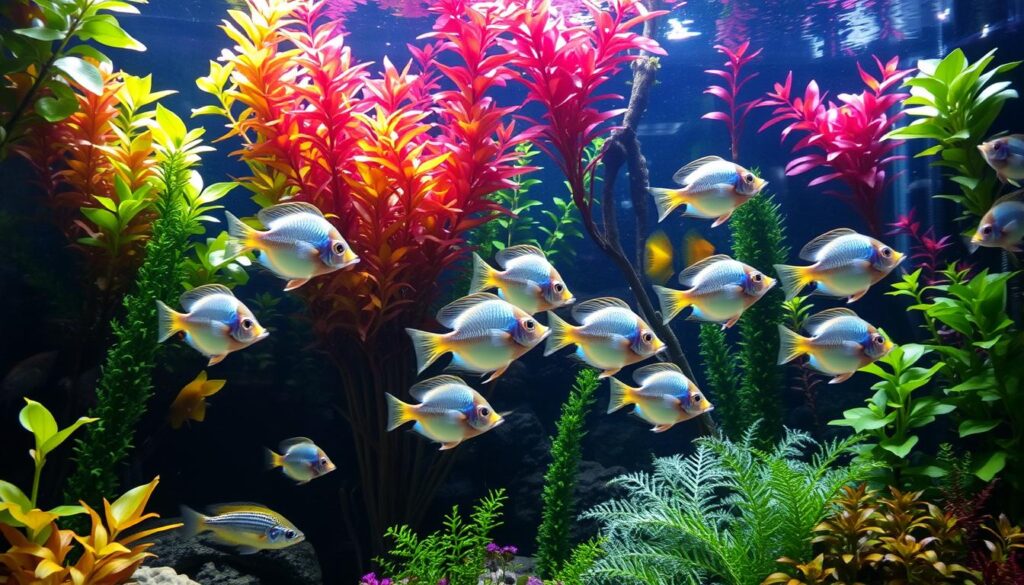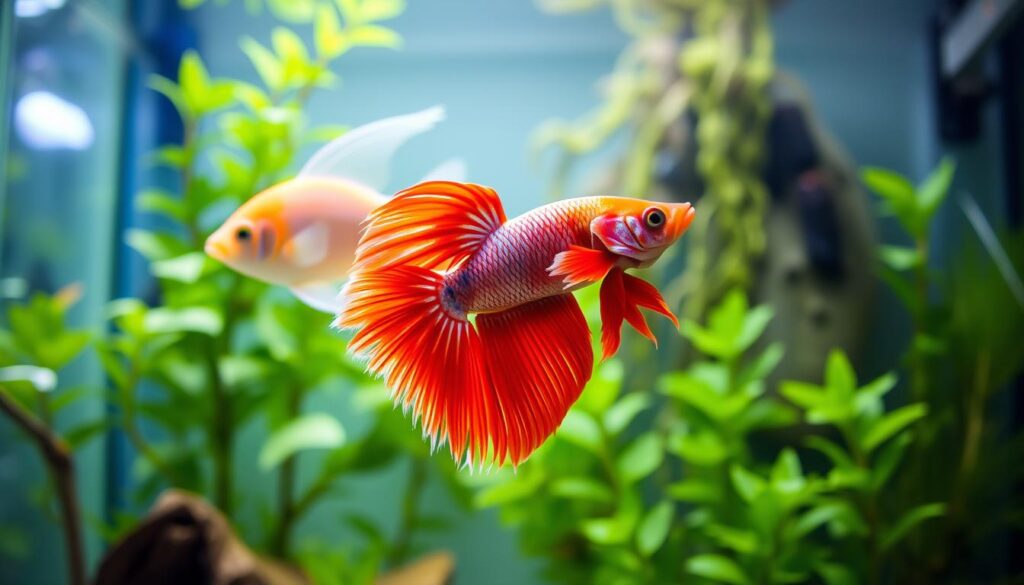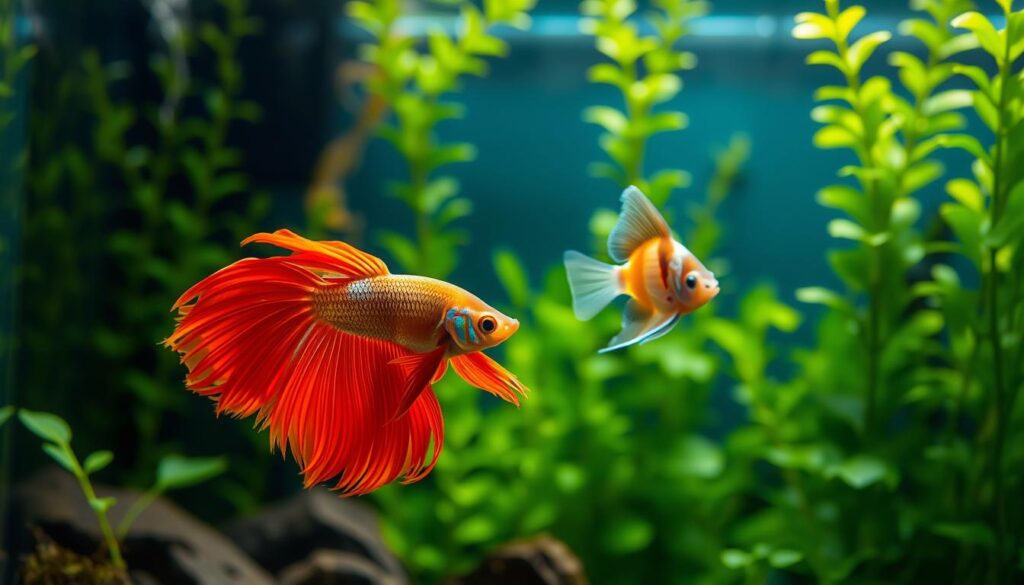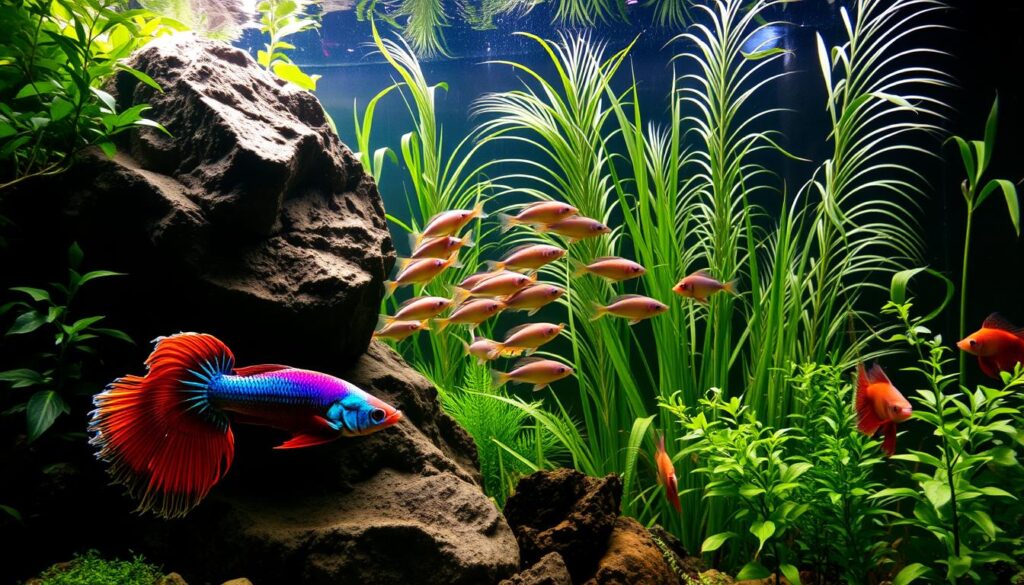If you’re setting up a community tank and wondering, “Can Betta fish live with Angelfish?”, you’re not alone. Many aquarium enthusiasts debate the compatibility of these two species. While both fish are beautiful and popular choices for aquariums, understanding their personalities and needs is key to ensuring a peaceful coexistence. In this guide, we’ll explore whether Betta fish and Angelfish can thrive together in the same tank, offering tips on how to keep your aquarium harmonious.
Key Takeaways
- Understanding the nature of betta fish and their compatibility with other species.
- Exploring the characteristics of angelfish and their requirements.
- Learning how to create a harmonious community tank.
- Discovering the benefits of housing betta fish with angelfish.
- Identifying potential challenges and solutions.
Understanding Betta Fish: Characteristics and Requirements
Knowing the basics of betta fish is key to creating a good home for them, whether alone or with other fish like angelfish. These fish are famous for their fancy fins and bright colors. They are a favorite among those who love aquariums.
Read Also The Right Betta Tank Size: Keeping Female Bettas in 5 Gallons
Natural Habitat and Behavior of Bettas
Betta fish come from slow-moving waters in Thailand. They live in shallow, plant-filled areas. In their natural home, betta fish are not great swimmers and often stay near the surface or hide in plants.
This behavior is important to remember when setting up their aquarium at home.
Tank Requirements for Healthy Bettas
To keep betta fish healthy, their tank should be like their natural home. They need a tank of at least 5 gallons. The water should be between 76-82°F, and there should be gentle water flow. Avoid strong currents, as betta fish are not strong swimmers.
Temperament and Social Behavior to Consider
Male betta fish are very territorial and can be aggressive towards other betta fish, especially males. When picking tankmates for betta fish, like angelfish, it’s important to know their temperament and social behavior. Some betta fish can live peacefully with other fish if introduced right and given enough space.
- Research the temperament of your betta fish.
- Choose tankmates that are compatible with betta fish.
- Monitor the behavior of all fish in the community tank.
Angelfish Essentials: What You Need to Know
Before mixing betta fish with angelfish, it’s key to know their basic needs and behaviors. Angelfish are popular for their looks and calm nature, especially when young. They make great additions to community tanks.

Natural Habitat and Behavior Patterns
Angelfish come from the warm, slow waters of the Amazon and Orinoco rivers. They live in dense vegetation and swim vertically. It’s important to mimic their natural habitat in your tank.
Optimal Tank Requirements for Angelfish
Angelfish can grow up to 6 inches tall. They need big tanks with lots of vertical space. A 20-gallon tank is a good start for one fish, with more space for each additional fish.
They prefer stable water. The temperature should be between 78-82°F, and the pH should be 6.8-7.8.
Temperament and Social Dynamics in Community Tanks
Young angelfish are usually peaceful. But, they can become territorial and aggressive as they grow. They can live with betta fish and other peaceful fish if introduced right and given enough space.
Knowing these basics helps decide if betta fish and angelfish can live together. It ensures a peaceful and thriving community tank.
Can Betta Fish Live with Angelfish? The Compatibility Question
Adding angelfish to a betta fish tank needs careful thought. Both species can be interesting in a community tank. But, their living together depends on several important factors.
Territorial Concerns and Aggression Potential
When keeping betta fish and angelfish together, territorial behavior is a big issue. Betta fish are very territorial and aggressive, especially towards fish with long fins like angelfish. Aggression can be reduced by adding lots of hiding spots and visual barriers in the tank.
A well-designed tank layout can help reduce fights between these fish. For example, using plants or decorations to create separate areas can lessen their interactions.
Size Differences and Swimming Space Needs
Angelfish grow big and need lots of room to swim. Betta fish like to stay in the middle and upper parts of the tank. A big tank with enough space is key for both species.
| Fish Species | Adult Size | Swimming Level |
|---|---|---|
| Betta Fish | 3 inches | Middle to Upper |
| Angelfish | 6 inches | Middle to Upper |
Water Parameter Compatibility Analysis
Betta fish and angelfish need different water conditions. Betta fish like warmer, softer water, while angelfish do well in slightly softer to neutral water. Finding a middle ground is important for them to live together.
“The key to successfully keeping betta fish and angelfish together lies in understanding and meeting their specific needs.”
By checking and adjusting water parameters, you can make a peaceful home for both species.

Common Myths About Betta and Angelfish Cohabitation
Many people think betta and angelfish can’t live together. But what’s true? These myths stop many from trying to keep them as tank mates.
Debunking the “Always Aggressive” Myth
Some think betta fish are always mean to other fish, like angelfish. But, not all betta fish are aggressive towards angelfish. It really depends on the betta’s personality.
The Truth About Tank Size Requirements
Many believe you need a huge tank for betta and angelfish. But, a minimum tank size of 20 gallons is enough. The tank should also have lots of plants and hiding spots.
Misconceptions About Water Conditions
Some think betta and angelfish need different water types. But, both like warm, slightly acidic to neutral water. A well-kept tank with the right water can support both.
| Myth | Reality |
|---|---|
| Betta fish are always aggressive. | Individual temperament plays a significant role. |
| A huge tank is needed. | A minimum of 20 gallons is recommended. |
| Incompatible water conditions. | Both thrive in warm, slightly acidic to neutral water. |

Factors That Influence Successful Cohabitation
To keep betta fish and angelfish together, it’s important to know what helps. The success of living together depends on the tank, the fish’s nature, and their genders.
Tank Size and Layout Considerations
The tank’s size and design are key. A big tank with lots of room and hiding spots helps avoid fights and territorial behavior.
A tank of at least 20 gallons is best. It should have many plants and decorations to help fish have their own spaces.
Individual Fish Temperaments and Selection Tips
The nature of both betta and angelfish matters a lot. Some betta fish are aggressive, while others are calm. Angelfish can also be territorial. Choosing fish that are easy-going is important for them to live well together.
Gender Combinations That Work Best
The gender of the fish can affect how well they get along. Usually, a female betta is better with angelfish than a male. This is because male betta fish are often more aggressive.
| Factor | Consideration | Recommendation |
|---|---|---|
| Tank Size | Space and hiding places | Minimum 20 gallons |
| Fish Temperament | Aggression level | Select calm individuals |
| Gender Combination | Compatibility | Female betta with angelfish |
Setting Up the Ideal Tank for Bettas and Angelfish
Setting up a tank for betta fish and angelfish needs careful thought. You’ll learn how to make a community tank that’s perfect for both. This tank will be a great place for them to live together.
Selecting the Appropriate Tank Size
Choosing the right tank size is key when keeping betta fish and angelfish together. A 30-gallon tank is the minimum needed. It gives them enough room to live comfortably and helps prevent fights.
Creating Defined Territories and Zones
To avoid fights, you need to divide the tank into areas. Use plants, decorations, and barriers to do this. This way, each fish has its own space, reducing stress and aggression.

Essential Equipment and Filtration Systems
A good filtration system is crucial for a healthy tank. Choose a high-quality canister or submersible filter. Also, a heater is needed to keep the water at 78-82°F (25-28°C), perfect for both species.
Strategic Plant Placement and Decoration Selection
Plants and decorations make the tank look good and help the fish feel safe. Pick plants that add texture and height, like Java moss and Amazon swords. For decorations, choose items that offer shelter and define territories, such as driftwood or rock caves.
| Tank Element | Purpose | Recommended Options |
|---|---|---|
| Plants | Provide hiding places, create territories | Java moss, Anubias, Amazon swords |
| Decorations | Create separate territories, provide shelter | Driftwood, rock caves |
| Filtration System | Maintain water quality, reduce stress | Canister filter, submersible filter |
By focusing on these elements, you can make a great community tank. It will be a beautiful home for both betta fish and angelfish. Always think about what’s best for both species to keep the tank peaceful and happy.
Step-by-Step Guide to Introducing Betta and Angelfish
Introducing betta and angelfish to each other needs a slow and careful approach. This method helps them live together peacefully. It makes a community tank where both species can do well.
Proper Quarantine Procedures Before Introduction
Quarantine is key before putting betta and angelfish in the same tank. It stops diseases from spreading and lets you check for health issues. Quarantine should last for at least two weeks.
Dr. Erik Johnson, an aquarist and fish expert, says, “Quarantining new fish is like doing a background check; it ensures you’re not introducing potential problems into your community tank.” This shows the value of patience and carefulness in quarantine.
The Gradual Introduction Process
The introduction should be slow to avoid stress and fights. Start by keeping the fish in separate tanks or containers in the same room. This lets them get used to each other without immediate danger.
- Begin by visually introducing the fish to each other.
- Once they seem comfortable, start exchanging water between their tanks to match water conditions.
- After a few days, start the gradual mixing process by releasing one fish into the other’s tank, starting with the more docile fish.
Monitoring Behavior and Stress Signs
Watching the behavior of both fish during and after introduction is key. Look for stress signs like finned nipping, hiding, or rapid breathing. If you see these signs, separate the fish and start again more slowly.
| Stress Sign | Possible Cause | Action to Take |
|---|---|---|
| Finned nipping | Aggression or territorialism | Separate the fish and restart introduction |
| Hiding | Stress or fear | Provide more hiding places and reduce stress |
| Rapid breathing | Stress or water quality issues | Check water parameters and improve quality |
By following these steps and being patient, you can successfully introduce betta fish and angelfish to the same tank. This creates a diverse and thriving aquatic community.
Maintaining a Peaceful Community Tank
Creating a peaceful community tank is possible with the right care. This includes keeping the water clean and feeding your fish well. Understanding your tank’s ongoing needs is key to a happy home for your betta and angelfish.
Weekly and Monthly Maintenance Schedule
Keeping your tank healthy requires regular upkeep. I suggest doing a 25% water change weekly to keep the water fresh. Monthly, clean the gravel, check your equipment, and watch the water’s health.
| Task | Frequency |
|---|---|
| Water Change | Weekly (25%) |
| Gravel Cleaning | Monthly |
| Equipment Check | Monthly |
Water Parameter Testing and Management
Testing your water regularly is crucial for your fish’s health. I recommend checking pH, ammonia, nitrite, and nitrate levels often. Keeping the water just right helps reduce stress and aggression in your fish.
Optimal water parameters for betta and angelfish are a pH of 6.5 to 8. Make sure ammonia and nitrite levels are zero.
Feeding Strategies to Minimize Aggression
Feeding your fish right can help prevent fights. I suggest feeding small, frequent meals. This keeps them happy and avoids food fights.
Troubleshooting Common Problems and Interventions
Even with careful planning, betta and angelfish tankmates can face challenges. Aggression, stress, and territorial disputes may happen. These issues need quick action to keep your aquarium peaceful.
Recognizing Signs of Aggression and Stress
It’s key to watch for signs of aggression and stress in your fish. Look for visible injuries, excessive hiding, or rapid breathing. If you see these signs, find out why and fix it fast to avoid more problems.
Emergency Separation Techniques and Temporary Solutions
When aggression or stress gets too much, emergency separation might be needed. A divider can keep the aggressive fish away from others. Also, rearranging tank decorations can help reduce territorial fights.
When to Permanently Separate Your Fish
If aggression doesn’t stop, even with trying everything, it might be time to permanently separate your betta and angelfish. This should be after you’ve tried all other solutions. Always put your fish’s well-being first.
By staying alert and meeting your fish’s needs, you can avoid fights. This way, you can have a happy community tank.
Conclusion
In conclusion, betta fish and angelfish can live together if you plan carefully. We’ve looked at their needs and how they get along. This shows both the good and the bad of keeping them together.
To make it work, you need to think about tank size, fish personalities, and water quality. Knowing these things helps you create a happy home for both species. This way, you can enjoy their beauty together.
Whether betta fish and angelfish can live together depends on your care. With the right knowledge, you can have a beautiful tank. You’ll see how well they can get along, like can betta fish live with angelfish and betta fish compatibility with angelfish.

